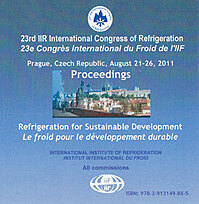
Document IIF
Stratégies optimales de régulation d'un système à refroidisseurs multiples, basées sur la distribution de la densité de probabilité du taux de charge thermique.
Optimal control strategies for multi-chiller system based on probability density distribution of cooling load ratio.
Résumé
Probability density distribution profile of cooling load ratio is obtained by Parzen window density estimation method, which is used to describe the variation tendency of the cooling load for HVAC system in the whole year. Based on the analysis of probability density distribution profile, three optimal sequence control strategy are presented. On the basis of analyzing for three optimal sequence control strategies, the optimal load allocation control strategy is presented. The load allocation and running numbers of chillers are calculated by using branch and bound algorithm to solve the nonlinear programming problem with hybrid constraints. For reducing the optimal calculation complexity and keep the system operating stable, three improved optimal load allocation control strategies are presented. These optimal control strategies presented are tested with simulation. Simulation results show that these optimal control strategies presented can save more energy for HVAC system than the original sequence control strategy.
Documents disponibles
Format PDF
Pages : 8 p.
Disponible
Prix public
20 €
Prix membre*
Gratuit
* meilleur tarif applicable selon le type d'adhésion (voir le détail des avantages des adhésions individuelles et collectives)
Détails
- Titre original : Optimal control strategies for multi-chiller system based on probability density distribution of cooling load ratio.
- Identifiant de la fiche : 30002095
- Langues : Anglais
- Source : Proceedings of the 23rd IIR International Congress of Refrigeration: Prague, Czech Republic, August 21-26, 2011. Overarching theme: Refrigeration for Sustainable Development.
- Date d'édition : 21/08/2011
Liens
Voir d'autres communications du même compte rendu (569)
Voir le compte rendu de la conférence
Indexation
-
OPTIMIZATION TECHNIQUES FOR A CENTRIFUGAL CHILL...
- Auteurs : JOHNSON G. A.
- Date : 1985
- Langues : Anglais
Voir la fiche
-
OPTIMIZED CONTROL OF MULTIPLE CHILLERS.
- Auteurs : SPETHMANN D. H.
- Date : 1985
- Langues : Anglais
Voir la fiche
-
CHARACTERISTICS OF ICE AND FROST FORMATION ON T...
- Auteurs : MARINJUK B. T.
- Date : 24/09/1990
- Langues : Anglais
- Formats : PDF
Voir la fiche
-
Optimal environmental performance of water-cool...
- Auteurs : YU F. W., CHAN K. T.
- Date : 07/06/2010
- Langues : Anglais
- Source : ACRA2010. Asian conference on refrigeration and air conditioning: Tokyo, Japan, June 7-9, 2010.
- Formats : PDF
Voir la fiche
-
Modeling and comparison of different capacity m...
- Auteurs : INAMPUDI S., BOTTICELLA F., ELBEL S.
- Date : 09/2021
- Langues : Anglais
- Source : 12th International Conference on Compressors and their Systems
- Formats : PDF
Voir la fiche
